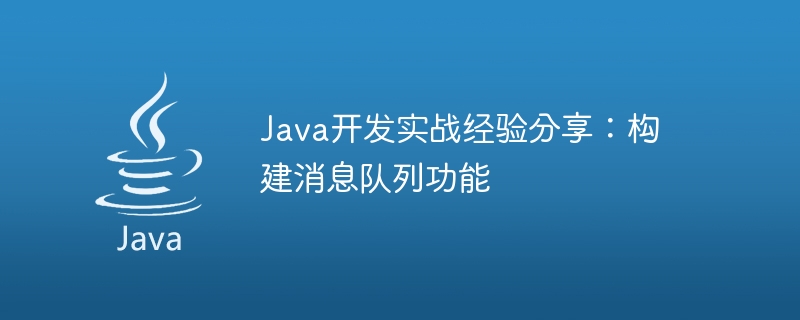Home >Java >javaTutorial >Java development practical experience sharing: building message queue function
Java development practical experience sharing: building message queue function
- PHPzOriginal
- 2023-11-20 11:47:001110browse

Java development practical experience sharing: building message queue function
Introduction:
With the advent of the Internet era, most applications need to process large amounts of data and news. In the traditional development model, data and message transfer between applications are usually implemented through direct function calls or database operations. However, as business requirements become more complex and scale expands, direct function calls and database operations can no longer meet the needs. In this case, using message queue as middleware to process data and messages asynchronously has become an effective solution.
1. What is a message queue?
Message queue is a mechanism for application decoupling and asynchronous processing, and it is also a typical producer-consumer model. It calls the message sender the producer and the message receiver the consumer, and implements message storage and delivery through a queue. Producers send messages to the queue, and consumers get messages from the queue for processing. Message queues can decouple producers and consumers and enable asynchronous processing, improving the scalability and stability of the system.
2. Why should we build the message queue function?
The purpose of building the message queue function is as follows:
- Asynchronous processing: By using the message queue, the application can asynchronousize time-consuming tasks and improve the response speed and performance of the system. .
- Decoupled application: Using message queue as middleware can decouple different modules and systems, reduce dependencies between modules, and improve system flexibility and maintainability.
- Peak shaving and valley filling: The message queue can be used as a buffer to balance the speed difference between producers and consumers to prevent the system from crashing due to sudden peaks.
- System scalability: By splitting the message queue into multiple partitions and copies, horizontal expansion and load balancing of the system can be achieved.
3. How to build the message queue function?
To build the message queue function, you can choose to use an existing message queue system, such as Kafka, RabbitMQ, etc., or you can build it from scratch. The following are the basic steps to build your own message queue function:
- Define the message format: First, you need to define the format of the message, including the structure and data type of the message. The structure of the message should be concise and clear to facilitate delivery and processing.
- Implement producers and consumers: The producer is responsible for sending messages to the queue, and the consumer is responsible for obtaining messages from the queue for processing. Threads and queues can be used to implement producers and consumers, and distributed technology can be used to implement highly available and load-balanced message queues.
- Implementing message queue: Message queue is the core component of message storage and delivery. Message queues can be implemented using memory queues, disk queues, or database queues. When designing a message queue, you need to consider the requirements for message sequence, persistence, and high availability.
- Processing messages: After consumers obtain messages from the queue, they need to process them accordingly. Message parsing, filtering, forwarding, storage and other operations can be performed according to business needs. When processing messages, it is necessary to ensure the idempotence and correctness of the messages.
- Monitoring and management: When building the message queue function, it is necessary to provide monitoring and management means. The message queue system can be monitored and managed in real time by monitoring the accumulation of message queues, consumer processing speed and error logs.
4. Case application: Using Kafka to build message queue function
Kafka is a high-throughput distributed publish-subscribe messaging system that can well meet large-scale data processing and message delivery needs. The following is a case of using Kafka to build a message queue function to illustrate in detail:
- Define the message format: Assuming that we need to process log information, we can define the message format as (time, level, content).
- Implement producers and consumers: We can use the Java API provided by Kafka to implement producers and consumers. Producers send messages to the Kafka cluster by calling APIs, and consumers obtain messages for processing by subscribing to topics.
- Create a Kafka cluster: We need to build a Kafka cluster to store and deliver messages. Multiple Kafka nodes can be used to achieve high availability and load balancing.
- Processing messages: After consumers obtain messages from the Kafka cluster, they can write the messages to the database, send emails, or perform other business processing.
- Monitoring and management: Kafka provides a complete set of monitoring and management tools that can monitor and manage the running status of the Kafka cluster in real time.
Conclusion:
By building the message queue function, application decoupling and asynchronous processing can be achieved, improving application performance and scalability. Whether you build it from scratch or use an existing message queue system, you need to consider the format of the message, the implementation of producers and consumers, the design of the message queue, and the requirements for monitoring and management. I hope this article can provide readers with some practical experience and inspiration and help them better build the message queue function.
The above is the detailed content of Java development practical experience sharing: building message queue function. For more information, please follow other related articles on the PHP Chinese website!
Related articles
See more- An introduction to the longitude and latitude conversion tool using Java to develop the Amap API
- How to implement message queue function in PHP microservices
- Summary of practical experience: Efficient development of Go language projects
- Practical experience sharing: efficient development of Go language projects

